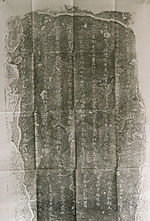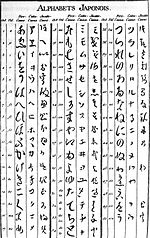century. The name "man'yōgana" derives from the Man'yōshū, a Japanese poetry anthology from the Nara period written with man'yōgana. Texts using the system...
23 KB (1,213 words) - 18:34, 9 August 2024
educated). Man'yōgana (万葉仮名, kana used in the Man'yōshū): the most prominent system of magana. Sōgana (草仮名, sloppy kana): cursive man'yōgana. Hiragana...
31 KB (2,933 words) - 08:51, 9 September 2024
full-fledged script for written Japanese existed until the development of man'yōgana (万葉仮名), which appropriated kanji for their phonetic value (derived from...
36 KB (4,203 words) - 14:19, 17 August 2024
sections are written in Man'yōgana, which uses kanji for their phonetic as well as semantic values. Based on the Man'yōgana system, Old Japanese can...
89 KB (10,155 words) - 22:05, 13 September 2024
purposes only. It represents an intermediate cursive form between historic man'yōgana script and modern hiragana. Sōgana appears primarily in Heian era texts...
2 KB (209 words) - 22:29, 26 June 2024
700s into the Man'yōgana system, a rebus-like transcription that uses specific kanji to represent Japanese phonemes. For instance, man'yōgana spells the...
30 KB (3,429 words) - 11:31, 30 August 2024
the katakana ナ two. Both represent [na]. な and ナ originate from the man'yōgana 奈. な is used as part of the okurigana for the plain negative forms of...
5 KB (154 words) - 18:27, 23 June 2022
from man'yōgana, Chinese characters used for their pronunciations, a practice that started in the 5th century. The oldest examples of Man'yōgana include...
52 KB (4,207 words) - 04:05, 14 September 2024
man'yōgana (万葉仮名), "alphabet of myriad leaves". The kana of modern Japanese, hiragana and katakana developed as organic simplifications of man'yōgana...
14 KB (1,594 words) - 21:49, 15 August 2024
significant for using the earliest Japanese writing system, the cumbersome man'yōgana. Though it was by no means the first use of this writing system—which...
34 KB (3,419 words) - 18:10, 9 August 2024
main Japanese syllabic writing system, derived from a cursive form of man'yōgana, a system where Chinese ideograms (kanji) were used to write sounds without...
29 KB (1,168 words) - 10:29, 4 September 2024
other language families have been proven. Old Japanese was written using man'yōgana, using Chinese characters as syllabograms or (occasionally) logograms...
76 KB (6,701 words) - 05:20, 8 September 2024
transliterate texts and works of arts from India, by taking parts of man'yōgana characters as a form of shorthand, hence this kana is so-called kata (片...
55 KB (4,642 words) - 04:06, 14 September 2024
transcribe the sounds of Japanese syllables. An early system of this type was man'yōgana, as used in the 8th-century anthology Man'yōshū. This system was not quite...
24 KB (2,796 words) - 07:17, 22 August 2024
U+3042, and the Unicode for ア is U+30A2. The katakana ア derives, via man'yōgana, from the left element of kanji 阿. The hiragana あ derives from cursive...
8 KB (446 words) - 22:39, 17 July 2024
Japan, the early use of Chinese characters for Japanese grammar was in man'yōgana, which was replaced by kana, the Japanese syllabic script. Characters...
6 KB (621 words) - 22:29, 23 June 2024
other Japanese syllabary besides hiragana and katakana is their precursor man'yōgana, use of which had died out well before 1712. Imatto-canna was probably...
2 KB (150 words) - 00:28, 31 May 2024
their sound values instead, in a system known as man'yōgana. Starting in the 9th century, specific man'yōgana were graphically simplified to create two distinct...
120 KB (14,109 words) - 09:05, 12 September 2024
specialised scholarly works use え / 𛀀 (from the man'yōgana character 衣) to transcribe e and 𛀁 / エ (from man'yōgana 江, where エ is the modern Katakana e) to transcribe...
29 KB (2,544 words) - 15:22, 6 September 2024
hiragana script. Specifically, hiragana developed from cursive forms of the man'yōgana script, called sōgana (草仮名). In Japan, the sōgana cursive script was considered...
8 KB (883 words) - 08:29, 2 September 2024
the fifth row (お段, "row O"). Both represent [o]. お and オ originate, via man'yōgana, from the kanji 於. Scaled-down versions of the kana (ぉ, ォ) are used to...
7 KB (321 words) - 22:41, 17 July 2024
colloquial readings Kanbun Idu Variants Zetian characters Derived systems Kana man'yōgana hiragana katakana Jurchen script Khitan large small Nüshu Bopomofo Slavonic...
21 KB (1,930 words) - 09:52, 5 September 2024
Tōyō kanji Jinmeiyō kanji Hyōgai kanji Kana Hiragana Hentaigana Katakana Man'yōgana Sōgana Gojūon Typographic symbols Japanese punctuation Iteration mark...
13 KB (1,007 words) - 04:33, 25 August 2024
in the modern kana syllabaries. Around 650 AD, a writing system called man'yōgana (used in the ancient poetry anthology Man'yōshū) evolved that used a number...
94 KB (9,715 words) - 04:33, 9 September 2024
literally means "bear root/origin," or "origin of the bear." However, Man'yōgana-like phonetic transcriptions based on the kanji for "a ball, a sphere"...
27 KB (1,189 words) - 14:45, 1 July 2024
and 𛀁 was merged with え and エ. Japanese people separated e and ye in Man'yōgana, early Hiragana and early Katakana. After that, e and ye merged into ye...
9 KB (602 words) - 23:59, 11 August 2024
used Chinese characters to express the sounds of Japanese, known as man'yōgana. Before the Taihō Code was established, the capital was customarily moved...
23 KB (2,415 words) - 14:45, 7 September 2024
colloquial readings Kanbun Idu Variants Zetian characters Derived systems Kana man'yōgana hiragana katakana Jurchen script Khitan large small Nüshu Bopomofo Slavonic...
48 KB (5,607 words) - 22:08, 7 September 2024
Tōyō kanji Jinmeiyō kanji Hyōgai kanji Kana Hiragana Hentaigana Katakana Man'yōgana Sōgana Gojūon Typographic symbols Japanese punctuation Iteration mark...
29 KB (2,722 words) - 18:38, 9 August 2024
that the writer wanted to write in order to write phonetically, much as man'yōgana (kanji used solely for phonetic use) was used to represent Japanese phonetically...
24 KB (1,944 words) - 03:45, 3 August 2024














